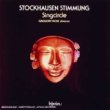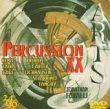Youth and Studies
Stockhausen was born on August 22,
1928, in Burg Mödrath, near Cologne, Germany. Stockhausen’s mother was institutionalized in the early thirties and subsequently died (probably not of natural causes, as the Nazis were not adverse to killing the mentally ill). His father was sent to the eastern front during World War II, dying there in 1945. After the war, Stockhausen lived with relatives and enrolled in the Cologne Musikhochschule (conservatory), receiving a degree in music education in 1951. In his spare time, he played jazz piano in bars and accompanied a magician. He also thought about becoming an author.
Stockhausen attended the Darmstadt Ferienkurse für Neue Musik (summer courses in new music) in 1951. He subsequently moved to Paris to study with Olivier Messiaen, who was then emerging as the mentor of a new radical group of young composers. There he became friends with Pierre Boulez (the acknowledged leader of this group). He also joined in the rediscovery of the music of Webern and Schoenberg, which had been rigorously suppressed in Nazi Germany.
Stockhausen’s early works, such as
Kreuzspiel and
Formel (both written in 1951) are examples of the common Darmstadt fascination with applying the
twelve-tone method associated with the
Second Viennese School to elements of music other than pitch, such as rhythm, articulation, and dynamics. Stockhausen quickly moved on from this “total
serialism” to consider the manner in which material is organized within pieces, concentrating on the proportions between groups of ideas and not just the constituents of those ideas.
Early Work
In 1953, Stockhausen returned to Germany to work at the Studio for
Electronic Music associated with the
radio station in Cologne, Nordwestdeutscher Rundfunk. Although only a few of his pieces had been performed, Stockhausen was widely seen, along with Boulez and others of the “Darmstadt School,” as a leading avant-garde composer. In part, this meteoric rise was made possible by the post-war cultural situation in Europe as a whole, and in Germany specifically. After the war there was an almost overwhelming urge to wipe the slate clean and begin anew. In Germany this meant finding artists who were not tainted by the Nazi era and whose work bore no relationship to the art that was promulgated by the regime.
In this regard Stockhausen was ideal. Not only had he been orphaned by the Nazi state and the war, but he was also a brilliant and exceptionally self-assured young composer whose works sounded like nothing anyone had heard before. What set Stockhausen apart was his willingness to go beyond traditional musical premises and to rethink completely the bases of composition. Over the course of his career he came to apply a large and continuously expanding set of ideas to the questions of how to organize sounds and the possible meanings of the concert setting.
Stockhausen’s work at the Studio for
Electronic Music in Cologne produced such now-classic works as
Kontakte (1958) and
Gesang der Jünglinge (1955-6). In the latter work, the sound sources consist of the manipulated speech sounds of his son reciting a few words from the book of Daniel in which three youths are consigned to the “fiery furnace” but do not die. This work was controversial both because he had treated a scriptural text in such a radical way and because, in post-Holocaust Germany, this particular text had powerful associations.
The best-known of Stockhausen’s early pieces is
Gruppen (1955-7), in which three separate orchestras with three separate conductors present simultaneous streams of music, all coordinated with the application of serially organized “group” ratios. Boulez, the composer
Bruno Maderna, and Stockhausen himself led the first performance.
Like many post-War radicals, Stockhausen was enormously affected by the work and ideas of John Cage, inviting Cage to lecture at Darmstadt in 1958. His embrace, or partial embrace, of Cage’s principles of
indeterminacy contributed to an estrangement between Stockhausen and other members of the Darmstadt school, particularly Boulez.
The Sixties
The cultural turmoil of the 1960s had perhaps a more profound impact on Stockhausen than on other composers of the time. Throughout the sixties Stockhausen developed various compositional practices that can, on the one hand, be seen as an outgrowth of his contact with Cage, but, on the other hand, can also reflect the era’s profound questioning of accepted values of all kinds. Stockhausen devised what he called “moment form,” where isolated segments were composed without reference to earlier or later events. The assemblage of these moments was left up to the choice of the performers.
Another compositional technique, called “process pieces,” expanded music completely beyond the will of the composer by using short textual instructions, rather than the usual musical notation, as the only direction as to what to play. An example of these instructions, from the work
Aus den Sieben Tagen (
1968), consists of the phrase “Play a vibration in the rhythm of the universe.”
Throughout the 1960s Stockhausen tended to work with a smaller ensemble of performers dedicated to his music. The concerts often included live electronics or electronic processing as well. Stockhausen and his ensemble traveled extensively, culminating with the Osaka World’s Fair in
1970, where they performed daily for six months. Returning to Germany in
1971, Stockhausen accepted a position as Professor at the Cologne Musikhochschule, where he taught until
1977.
Licht
Beginning in
1977, Stockhausen began what is probably the most ambitious cycle ever essayed by a composer, entitled
Licht (Light). The piece is comprised of a series of seven operas, one for each day of the week. Each work is named after the day on which it is to be performed. In these operas, completed in
2003, Stockhausen works through his complex and highly individual spiritual ideas.
Focusing on three divine figures (Lucifer, Eve and the archangel Michael), the operas employ a vast array of forces: multiple choruses, orchestras, improvising musicians, electronics, and complex staging. Perhaps the most remarkable element of
Licht consists of four helicopters, each carrying one member of a string quartet, which hover over the concert hall and send real-time recordings of the music, as well as video and the sounds of the helicopters themselves, down to the hall. There, the sounds are played over speakers while the images are projected onto screens.
Stockhausen has systematically bought back the rights of all his scores and recordings and releases them himself. He also has a foundation and school based at his compound in Kürten, near Cologne, where he continues to work as of this writing. His current project is a set of twenty-four pieces, one for each hour of the day.
Reference:
Toop, Richard: ‘Stockhausen, Karlheinz,’ Grove Music Online ed. L. Macy (Accessed 6 November
2006), <http://www.grovemusic.com>


